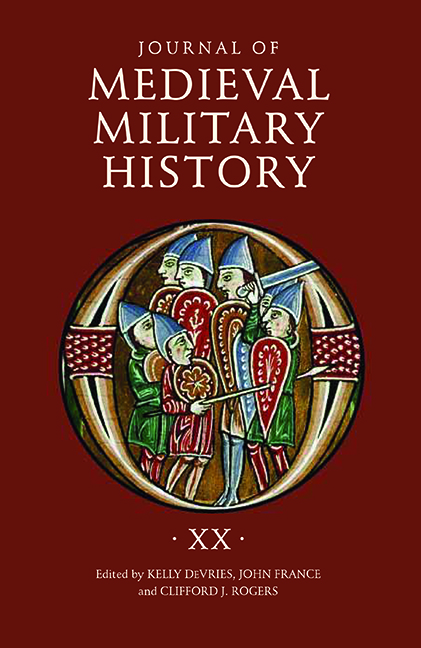Book contents
- Frontmatter
- Contents
- List of Illustrations
- 1 De velitatione bellica and the Georgian Art of War During the Reign of David IV
- 2 The Afterlife of the Medieval Christian Warrior
- 3 More Accurate Than You Think: Re-evaluating Medieval Warfare in Film
- 4 Raising the Medieval Trebuchet: Assembly Method and the Standing of a Half-scale Machine
- 5 Cum Socio Eiusdem: Military Recruitment in the Armies of Edward I Among the Sub-Gentry
- 6 Two Walls of Protection: Queen Elionor of Sicily and Bishop Berenguer de Cruïlles of Gerona During the 1359 Naval Campaigns of The War of the Two Pedros
- 7 The Lancegay and Associated Weapons
- 8 “I intend to give him battle.” Battle-Seeking in a Civil War Context: Toro (1476)
- 9 Discovery of an Early Sixteenth-Century Battle Plan from the Archdiocesan Archive in Ljubljana
- List of Contributors
- Journal of Medieval Military History 1477-545X
9 - Discovery of an Early Sixteenth-Century Battle Plan from the Archdiocesan Archive in Ljubljana
Published online by Cambridge University Press: 07 October 2022
- Frontmatter
- Contents
- List of Illustrations
- 1 De velitatione bellica and the Georgian Art of War During the Reign of David IV
- 2 The Afterlife of the Medieval Christian Warrior
- 3 More Accurate Than You Think: Re-evaluating Medieval Warfare in Film
- 4 Raising the Medieval Trebuchet: Assembly Method and the Standing of a Half-scale Machine
- 5 Cum Socio Eiusdem: Military Recruitment in the Armies of Edward I Among the Sub-Gentry
- 6 Two Walls of Protection: Queen Elionor of Sicily and Bishop Berenguer de Cruïlles of Gerona During the 1359 Naval Campaigns of The War of the Two Pedros
- 7 The Lancegay and Associated Weapons
- 8 “I intend to give him battle.” Battle-Seeking in a Civil War Context: Toro (1476)
- 9 Discovery of an Early Sixteenth-Century Battle Plan from the Archdiocesan Archive in Ljubljana
- List of Contributors
- Journal of Medieval Military History 1477-545X
Summary
Recent investigations in the Archdiocesan Archive (Nadškofijski arhiv) in Ljubljana, Slovenia, have uncovered a sketch depicting the tactical disposition of an army with over 40,000 combatants, composed of pikemen, arquebusiers, mounted men-at-arms, lightly armed hussar cavalry, mounted crossbowmen, and artillery. The archival context suggests that the document was created at the beginning of the Habsburg war against Venice (1508–16).
The “Ljubljana plan” represents a rare relic of Central European military thought from the early years of the sixteenth century but still firmly rooted in older medieval traditions. An analysis of its content reveals a cautious, conservative approach to warfare. Despite the very high proportion of cavalry and the central role of heavily armed men-at-arms, the troops are positioned in a largely defensive formation, protected on the flanks and rear with a wagon fort. This may ultimately reflect the contemporary experience of Habsburg armies fighting an elusive enemy – from the Ottoman and Hungarian light cavalry to the Venetian stradiots.
The Middle Ages have long been perceived as a “Dark Age” of military science during which the art of war had sunk to an unprecedented low point. No doubt this resulted in part from the relative lack of original theoretical texts produced by its protagonists. However, since the early decades of the twentieth century an increasing number of previously unknown primary sources have come to light that challenge old assumptions and present a rather more complex image of warfare in the Middle Ages.
One such discovery has been made recently in the Archdiocesan Archive (Nadškofijski arhiv) in Ljubljana, Slovenia. Among the extensive documentation from the late Middle Ages and the Early Modern period, the archive keeps a considerable body of records from the time of Bishop Christopher Rauber (c.1466–1536). These records, which have not been systematically investigated to date, also contain a collection of various documents produced during the Habsburg war against Venice (1508–16). In particular, one stands out from the military historian's perspective – a hastily sketched plan outlining a battle formation consisting of 41,500 troops.
To date, this fascinating find has escaped scholarly attention. The document itself perhaps raises more questions than it may answer.
- Type
- Chapter
- Information
- Journal of Medieval Military HistoryVolume XX, pp. 203 - 232Publisher: Boydell & BrewerPrint publication year: 2022

